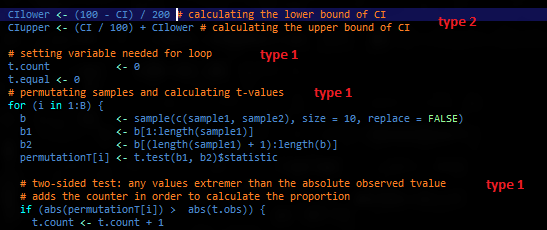我想在 Emacs 中构建一个正则表达式来清理我的 R 代码。
我遇到的问题之一是存在不同类型的评论: 您有一定数量的空白 (1),例如:
# This is a comment:
# This is also a comment
或者你遇到这样的情况(2):
require(lattice) # executable while the comment is informative
这个想法是,当注释属于第二种时(在可执行的内容之后),我想对齐注释,同时排除第一种注释。
理想情况下,它会将所有评论与第一种评论对齐,但不与第一种评论对齐。
示例:
funfun <- function(a, b) {
# This is a function
if (a == b) { # if a equals b
c <- 1 # c is 1
}
}
#
致:
funfun <- function(a, b) {
# This is a function
if (a == b) { # if a equals b
c <- 1 # c is 1
}
}
#
我找到了一个正则表达式来替换第一种,所以我能够按段落(标记段落)对齐它们。这效果很好。
问题就出在反向替换上:
(replace-regexp "^\\s-+#+" "bla" nil (point-min) (point-max))
这将从行的开头替换为任意数量的空格和任意数量的注释字符,例如:
#########
进入
bla
问题是我想将它们替换回原来的样子,所以“bla”必须返回到相同数量的空格和相同数量的#。
希望有人理解我正在尝试做的事情,并且对方法有更好的想法或知道如何解决此正则表达式部分。

最佳答案
嗯,这是一些疯狂的尝试,想做一些我认为你想做的事情。它似乎有效,但需要大量的测试和完善:
(defun has-face-at-point (face &optional position)
(unless position (setq position (point)))
(unless (consp face) (setq face (list face)))
(let ((props (text-properties-at position)))
(loop for (key value) on props by #'cddr
do (when (and (eql key 'face) (member value face))
(return t)))))
(defun face-start (face)
(save-excursion
(while (and (has-face-at-point face) (not (bolp)))
(backward-char))
(- (point) (save-excursion (move-beginning-of-line 1)) (if (bolp) 0 -1))))
(defun beautify-side-comments ()
(interactive)
;; Because this function does a lot of insertion, it would
;; be better to execute it in the temporary buffer, while
;; copying the original text of the file into it, such as
;; to prevent junk in the formatted buffer's history
(let ((pos (cons (save-excursion
(beginning-of-line)
(count-lines (point-min) (point)))
(- (save-excursion (end-of-line) (point)) (point))))
(content (buffer-string))
(comments '(font-lock-comment-face font-lock-comment-delimiter-face)))
(with-temp-buffer
(insert content)
(goto-char (point-min))
;; thingatpt breaks if there are overlays with their own faces
(let* ((commentp (has-face-at-point comments))
(margin
(if commentp (face-start comments) 0))
assumed-margin pre-comment commented-lines)
(while (not (eobp))
(move-end-of-line 1)
(cond
((and (has-face-at-point comments)
commentp) ; this is a comment continued from
; the previous line
(setq assumed-margin (face-start comments)
pre-comment
(buffer-substring-no-properties
(save-excursion (move-beginning-of-line 1))
(save-excursion (beginning-of-line)
(forward-char assumed-margin) (point))))
(if (every
(lambda (c) (or (char-equal c ?\ ) (char-equal c ?\t)))
pre-comment)
;; This is the comment preceded by whitespace
(setq commentp nil margin 0 commented-lines 0)
(if (<= assumed-margin margin)
;; The comment found starts on the left of
;; the margin of the comments found so far
(save-excursion
(beginning-of-line)
(forward-char assumed-margin)
(insert (make-string (- margin assumed-margin) ?\ ))
(incf commented-lines))
;; This could be optimized by going forward and
;; collecting as many comments there are, but
;; it is simpler to return and re-indent comments
;; (assuming there won't be many such cases anyway.
(setq margin assumed-margin)
(move-end-of-line (1- (- commented-lines))))))
((has-face-at-point comments)
;; This is the fresh comment
;; This entire block needs refactoring, it is
;; a repetition of the half the previous blockp
(setq assumed-margin (face-start comments)
pre-comment
(buffer-substring-no-properties
(save-excursion (move-beginning-of-line 1))
(save-excursion (beginning-of-line)
(forward-char assumed-margin) (point))))
(unless (every
(lambda (c)
(or (char-equal c ?\ ) (char-equal c ?\t)))
pre-comment)
(setq commentp t margin assumed-margin commented-lines 0)))
(commentp
;; This is the line directly after a block of comments
(setq commentp nil margin assumed-margin commented-lines 0)))
(unless (eobp) (forward-char)))
;; Retrieve back the formatted contnent
(setq content (buffer-string))))
(erase-buffer)
(insert content)
(beginning-of-buffer)
(forward-line (car pos))
(end-of-line)
(backward-char (cdr pos))))
我还在pastebin上复制了它以提高可读性:http://pastebin.com/C2L9PRDM
编辑:这应该恢复鼠标位置,但不会恢复滚动位置(也许可以,我只需要查找滚动的存储方式)。
关于用于 R 注释的正则表达式 Emacs,我们在Stack Overflow上找到一个类似的问题: https://stackoverflow.com/questions/13439218/